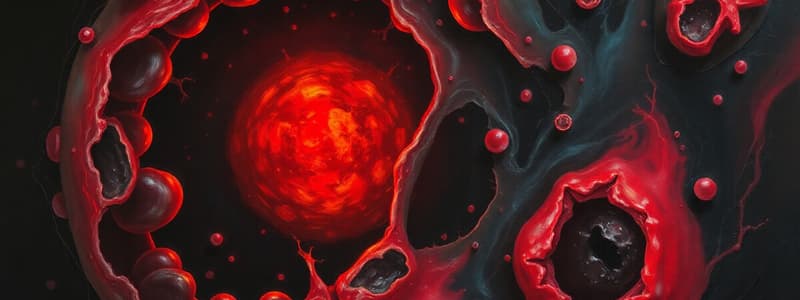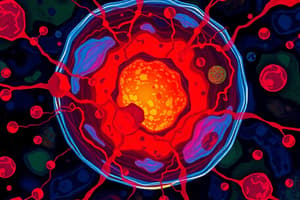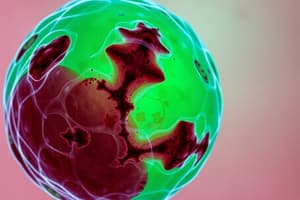Podcast
Questions and Answers
What characterizes necrosis?
What characterizes necrosis?
- Cell shrinkage and a reduction in intracellular protein synthesis
- Self-digestion of cells leading to tissue repair
- Programmed cell death under normal physiological conditions
- Cell swelling, protein denaturation, and organellar breakdown (correct)
Which mechanism of cell injury is associated with inadequate oxygenation of blood?
Which mechanism of cell injury is associated with inadequate oxygenation of blood?
- Genetic defects
- Trauma from physical agents
- Hypoxia specifically (correct)
- Chemical alteration of membrane permeability
In which of the following scenarios does apoptosis occur?
In which of the following scenarios does apoptosis occur?
- During an anaphylactic shock reaction
- Following exposure to severe physical trauma
- As a natural part of physiological processes (correct)
- When there is a sudden lack of nutrients
Which intracellular system is NOT vulnerable to injury?
Which intracellular system is NOT vulnerable to injury?
What is the main role of the cytosolic free calcium level in cells?
What is the main role of the cytosolic free calcium level in cells?
Which type of injury results from the body's immune system's response?
Which type of injury results from the body's immune system's response?
What is one of the consequences of increasing levels of cytosolic calcium?
What is one of the consequences of increasing levels of cytosolic calcium?
Which condition is closely linked to atherosclerosis due to dietary factors?
Which condition is closely linked to atherosclerosis due to dietary factors?
What is the primary cause of cytoplasmic eosinophilia?
What is the primary cause of cytoplasmic eosinophilia?
Which type of necrosis is characterized by preservation of cell structural outlines?
Which type of necrosis is characterized by preservation of cell structural outlines?
What kind of injury leads to fatty change in liver and myocardial cells?
What kind of injury leads to fatty change in liver and myocardial cells?
What describes Karyorrhexis in nuclear changes?
What describes Karyorrhexis in nuclear changes?
What is the primary process involved in necrosis?
What is the primary process involved in necrosis?
Which statement about gangrenous necrosis is true?
Which statement about gangrenous necrosis is true?
Which structure undergoes dilatation and detachment of ribosomes during necrosis?
Which structure undergoes dilatation and detachment of ribosomes during necrosis?
What type of necrosis is primarily associated with tuberculous infection?
What type of necrosis is primarily associated with tuberculous infection?
What role do free radicals play in cellular injury?
What role do free radicals play in cellular injury?
Which chemical species is a product of the reduction of molecular oxygen during redox reactions?
Which chemical species is a product of the reduction of molecular oxygen during redox reactions?
Which of the following is NOT a consequence of oxygen free radical interactions with cellular components?
Which of the following is NOT a consequence of oxygen free radical interactions with cellular components?
What causes the rapid breakdown of the endoplasmic reticulum when carbon tetrachloride is metabolized in the liver?
What causes the rapid breakdown of the endoplasmic reticulum when carbon tetrachloride is metabolized in the liver?
What is the main feature of hydropic changes seen in reversible cell injury?
What is the main feature of hydropic changes seen in reversible cell injury?
Which of the following best describes the process of chemical injury in cells?
Which of the following best describes the process of chemical injury in cells?
What is a primary factor that leads to oxidative damage in cells?
What is a primary factor that leads to oxidative damage in cells?
How do transition metals like Copper and Iron contribute to free radical formation?
How do transition metals like Copper and Iron contribute to free radical formation?
What characterizes fat necrosis following acute pancreatitis?
What characterizes fat necrosis following acute pancreatitis?
What triggers the process of apoptosis?
What triggers the process of apoptosis?
What is the result of apoptotic cell death?
What is the result of apoptotic cell death?
In which situation would apoptosis typically occur?
In which situation would apoptosis typically occur?
What is a common feature of intracellular accumulations?
What is a common feature of intracellular accumulations?
Which of the following statements about apoptosis is true?
Which of the following statements about apoptosis is true?
What can lead to abnormal intracellular accumulation?
What can lead to abnormal intracellular accumulation?
Which condition indicates a storage disease?
Which condition indicates a storage disease?
What term refers to the deposition of calcium in dead or dying tissues despite normal serum calcium levels?
What term refers to the deposition of calcium in dead or dying tissues despite normal serum calcium levels?
Which process involves an increase in cell size due to increased synthesis of structural proteins?
Which process involves an increase in cell size due to increased synthesis of structural proteins?
What causes metastatic calcification to occur?
What causes metastatic calcification to occur?
Which condition is NOT a cause of hypercalcemia?
Which condition is NOT a cause of hypercalcemia?
In which organs is metastatic calcification predominantly found?
In which organs is metastatic calcification predominantly found?
What is atrophy characterized by?
What is atrophy characterized by?
Which cellular adaptation results from a normal physiological response to hormonal stimulation, such as in pregnancy?
Which cellular adaptation results from a normal physiological response to hormonal stimulation, such as in pregnancy?
What is the consequence of extensive nephrocalcinosis?
What is the consequence of extensive nephrocalcinosis?
Flashcards are hidden until you start studying
Study Notes
Cell Injury
- Cell injury occurs when cells are unable to adapt to stress or stimuli.
- Two main types of cell death:
- Necrosis: Cell death due to injury, characterized by swelling, protein denaturation, and organelle breakdown.
- Apoptosis: Programmed cell death occurring normally or under specific conditions.
- Causes of Cell Injury:
- Hypoxia: Inadequate oxygen supply affecting aerobic respiration.
- Physical agents: Trauma, temperature extremes, radiation, electric shock, pressure changes.
- Chemicals and drugs: Alter membrane permeability, osmotic balance, or enzyme function.
- Microbiologic agents: Viruses, bacteria, and parasites.
- Immunologic reactions: Immune system responses causing cell damage.
- Genetic defects: Inherited disorders like Down syndrome and sickle cell anemia.
- Nutritional imbalances: Protein-calorie deficiency, vitamin deficiencies, and high animal fat diets.
- Aging: Cellular processes decline with time.
Mechanisms of Cell Injury
- Cell response to injury depends on type, duration, and severity.
- Four main intracellular systems are vulnerable:
- Cell membrane integrity: Affects ionic and osmotic balance.
- Aerobic respiration: Energy production.
- Protein synthesis: Producing essential molecules.
- Genetic apparatus: DNA function and repair.
Free Radical Mediation of Cell Injury
- Free radicals: Unstable molecules with unpaired electrons, highly reactive.
- Implicated in chemical and radiation injury, oxygen toxicity, aging, microbial killing, inflammation, and tumor destruction.
- Sources of free radicals within cells:
- Absorption of radiant energy (e.g., water hydrolysis to OH• and H•).
- Redox reactions (normal metabolism, generating superoxide radicals, hydrogen peroxide, and hydroxyl radicals).
- Enzymatic catabolism of oxygenous chemicals (e.g., CCl4 conversion to CCl3• in the liver).
Chemical Injury
- Two main mechanisms:
- Direct combination with critical components: Mercury binding to sulfhydryl groups, inhibiting ATP transport.
- Conversion to reactive metabolites: P-450 oxidases in the SER convert chemicals to toxic forms (e.g., CCl4 to CCl3•).
Patterns of Acute Cell Injury
- Reversible Cell Injury:
- Light microscopic changes:
- Cell swelling (hydropic changes or vacuolar degeneration).
- Cytoplasmic eosinophilia (acidic cytoplasm and loss of ribosomes).
- Fatty change (seen in hypoxic and chemical injury in liver and heart).
- Ultrastructural changes:
- Plasma membrane blebbing, microvilli distortion, loosened intercellular attachments.
- Mitochondrial swelling and amorphous densities.
- Endoplasmic reticulum dilatation, ribosome detachment, and polysome dissociation.
- Nuclear alterations (disaggregation of granular elements).
- Light microscopic changes:
Necrosis
- Morphologic changes following cell death in living tissue.
- Result of enzymatic digestion and protein denaturation.
- Cytoplasmic changes: Eosinophilia, glassy appearance, vacuolation, and calcification.
- Nuclear changes: Karyolysis (DNA digestion), pyknosis (nuclear shrinkage and increased basophilia), karyorrhexis (pyknotic nucleus fragmentation).
Types of Necrosis
- Coagulative necrosis: Preservation of structural outlines due to protein denaturation (e.g., myocardial infarction).
- Liquefactive necrosis: Caused by bacterial or fungal infections, leading to liquefaction (e.g., brain).
- Gangrenous necrosis: Ischemic coagulative necrosis with superimposed infection (wet gangrene).
- Caseous necrosis: Cheesy, white appearance seen in tuberculosis, with amorphous granular debris.
- Fat necrosis: Focal fat destruction due to pancreatic enzymes (e.g., pancreatitis).
Apoptosis
- Programmed cell death occurring in normal and pathological conditions.
- Features: Single or clusters of cells with intense eosinophilic cytoplasm, condensed nuclear chromatin, karyorrhexis, cell shrinkage, and fragmentation into apoptotic bodies.
- Does not elicit inflammation.
- Initiation: Withdrawal of growth factors, receptor engagement, injury by radiation, toxins, and free radicals, intrinsic protease activation.
Intracellular Accumulations
- Normal cells may accumulate abnormal substances.
- Categories:
- Excess normal endogenous substance (e.g., fatty change in the liver).
- Accumulation due to metabolic defects (storage diseases).
- Deposition in dead or dying tissues (dystrophic calcification).
Metastatic Calcification
- Occurs in normal tissues due to hypercalcemia.
- Causes: Hyperparathyroidism, tumors, vitamin D intoxication, milk alkali syndrome, sarcoidosis, renal failure.
- Location: Interstitial tissues, kidneys, lungs, gastric mucosa.
Cellular Adaptations of Growth and Differentiation
- Atrophy: Shrinkage of cell size due to loss of cell substance.
- Causes: Decreased workload, loss of innervation, decreased blood supply, inadequate nutrition, loss of endocrine stimulation, aging.
- Biochemically: Decreased synthesis, increased catabolism, or both.
Hypertrophy
- Increase in cell size due to increased protein synthesis and organelles.
- Leads to an increase in organ size.
Studying That Suits You
Use AI to generate personalized quizzes and flashcards to suit your learning preferences.




